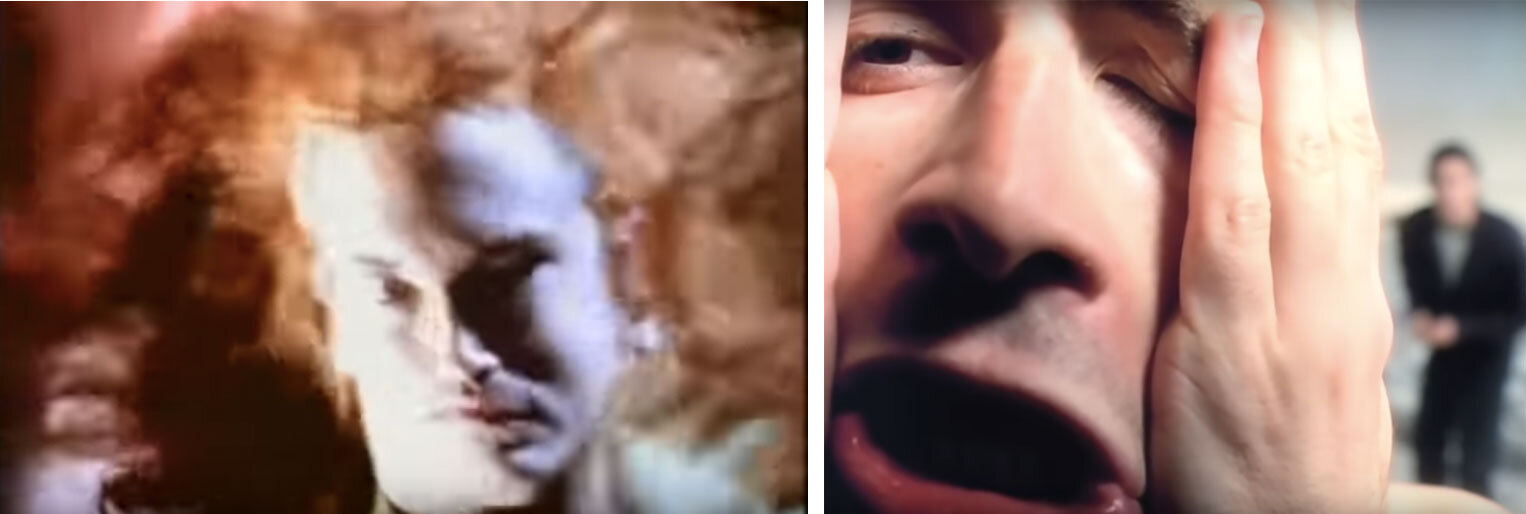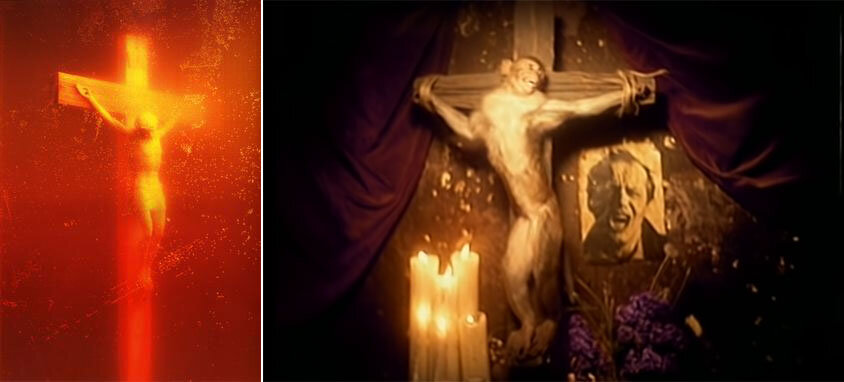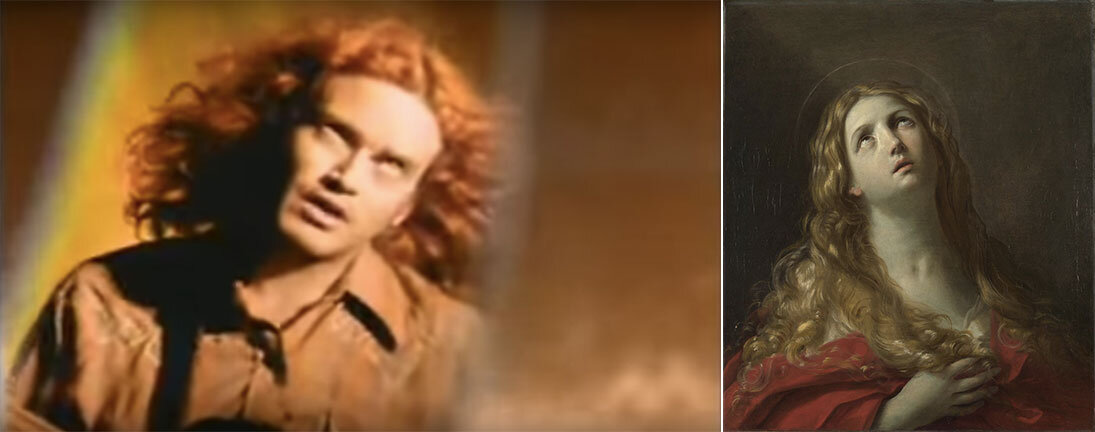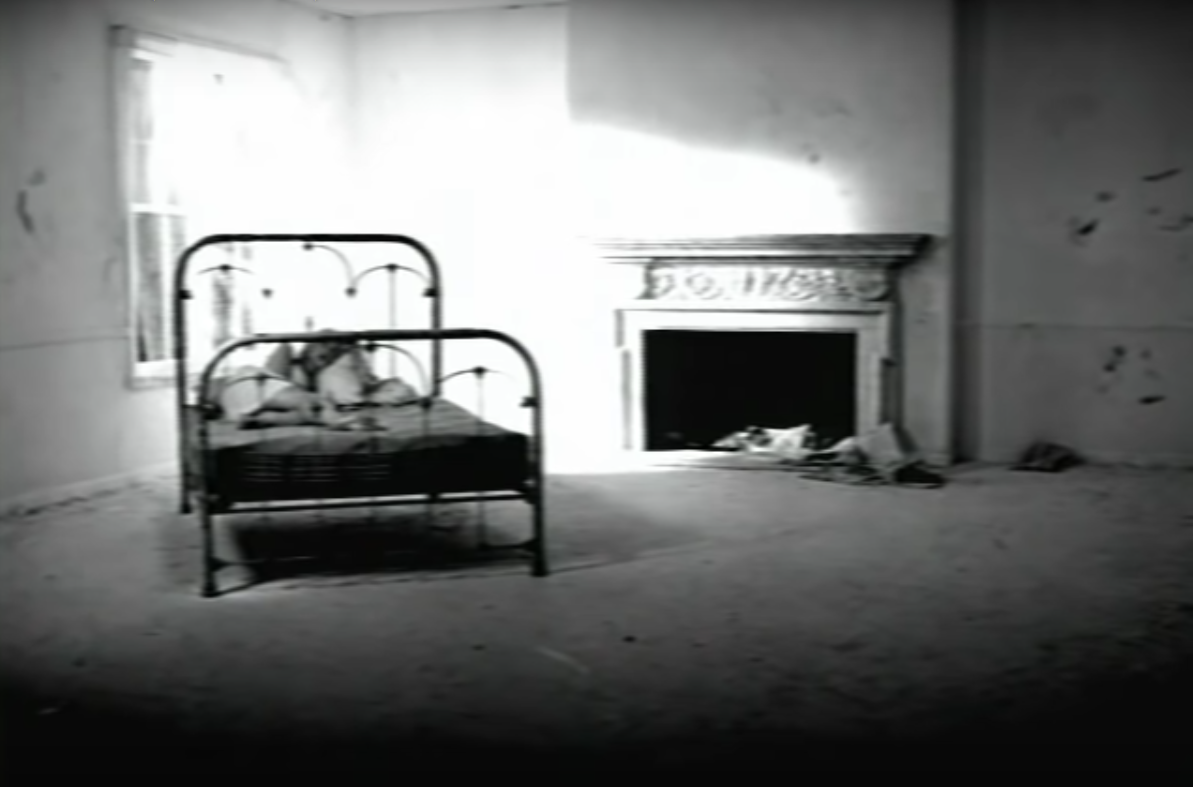or Toward an Understanding of the Elements of the Grunge Music Video, Incorporating an Examination of “Backwater” by Meat Puppets, Directed by Rocky Schenck, by will hansen
I. SELLING NOT SELLING (OUT)
The quote in the alternative title comes from the opening of the (full version of the) video for Pearl Jam’s “Even Flow,” one of the handful of songs that defined grunge for the national audience. The next thing Eddie Vedder says to director Josh Taft is “Turn these lights out! This is a fucking rock concert!” MTV typically cut this first ten seconds from their many airings of the video.
So much work done in this handful of words; layers of useful irony embedded in the complaint. You probably don’t need me to explicate most of them, but here’s one that’s not obvious: this was not the first video made for “Even Flow.” Pearl Jam buried that attempt, set in a zoo, based on guitarist Stone Gossard’s concept, and directed by Rocky Schenck. Gossard himself rejected it as “totally rawk.” Yes: on its way to becoming a standard-bearer of a genre (or “genre,” maybe) built on contempt for self-promotion, superficiality, gloss, hypocrisy, and corporate greed, this band developed, for its song about a homeless man, its own promotional music video concept, then determined the (I’m sure it’s safe to assume, expensive) result to be embarrassingly aligned with the commercial look of hair metal, then, being filmed for a second attempt, very publicly denounced the lights necessary to any film shoot as an offense to its pure love of playing music for its fans.
It wasn’t just PJ. Most famously, Kurt Cobain oversaw editing of “Smells Like Teen Spirit,” adding a shot of his face (previously hidden behind his hair) at the end.
There is that fine line between the specious advertiser’s claim not to be selling anything and the acknowledgment that, to make your art discoverable, your art must take part in a system so ravenous that it will even sell disgust with that system. Better, perhaps, to draw the system into dialogue with your music as much as you can. (Of course, I can’t help but think as well of Winona Ryder’s earnest snapshot-of-a-generation camcorder documentary in Reality Bites—given over to “In Your Face TV” suit Ben Stiller and processed into a slick, glib, hyperactive music video collection of 1-second Gen-X sound bites. Creative control! Independent media!)
Contrary to the popular view of a “oh well, whatever, nevermind” slacker ethos—a pretty typical misreading of scabrous self-criticism as manifesto—understanding and caring about the music video as both collaborative art form and advertisement, as something too important and influential to be left only to label execs or film crews, seems like it may be a defining characteristic for grunge bands. Media literacy was simply mother’s milk to Gen X.
II. MEDIUM AND MESSAGE
Anyway, Rocky Schenck recovered from Pearl Jam’s rejection and got plenty of work directing music videos, across many genres (Adele, Emmylou Harris, Paul Westerberg) including grunge–Alice in Chains, Sponge, and, most successfully, “Backwater” by Meat Puppets. The song and video are quintessential grunge, and a fine case study around which to build the taxonomy of the grunge video.
OPTICS
“Backwater” begins with a doubled shot of Cris Kirkwood reflected in mirror fragments, and does not let up on the visual confusion from there. The video consistently fascinates and befuddles the eye; the dominant motif of jagged mirror fragments is combined with flowing and falling water and a complex lighting scheme. Watching “Backwater” in real time, I never can get a hold of where any band member really is, whether I’m seeing reflection or reality, or even what exactly the camera is shooting. Look at this–what’s going on here?
“A knife to open up the sky’s veins, ” “stand there looking backward,” “in the backwater swirling,” “hey I’m blind”–in creating a visual counterpart to the music, Schenck seems to have taken these as his lyrical cues, combined with the jagged-edged guitar and swampy bass.
“Backwater” is a masterpiece of optics, but there’s so much camera trickery and focus on vision itself throughout grunge videos. Autofocusing, fisheye lensing, visual plane shifting! This is what happens with art- and film-school grads were handed the reins instead of studio execs counting babes-per-second.
DISTORTION
Schenck uses a lot of water in the video, making whole shots seem as though they are taking place underwater or behind a scrim of waterfall. Facial distortion is a keynote here, and in other videos.
L: Meat Puppets, “Backwater,” dir. Rocky Schenck. R: Live, “I Alone,” dir. Tim Pope.
WEIRDO LIGHTING
Light flashes and streaks frequently in “Backwater.” Reflections off of those jagged mirrors, sure, but also reminiscent of lightning strikes or paparazzi cameras. Or moments of blinding clarity in a drug-addled mind.
Lighting that calls attention to itself is everywhere in grunge videos. Flashes, strobes, handheld or wandering spotlights are endemic in the era. As with so much else, “Weird Al” and director Jay Levey skewer the tic brilliantly in their video for “Smells Like Nirvana.”
Otherwise it’s pretty hard to capture the effect in stills. But take a look at Collective Soul’s “Shine” for one exemplar.
THE ROVING CAMERA
The coked-up quick-cut collage editing that makes up most music videos of the ’80s is slowed down–a bit–in grunge. Movement within shots makes up the difference in maintaining a frenetic pace to match the music. All those flashing lights, yes, and some movement by performers (though less of that than in, say, hair metal vids)–but also an increased emphasis on movement of the camera.
Gen X came of age along with the camcorder. There is also some kinship between the aesthetic of documentaries–shaky handheld footage, black and white–and the gritty “authenticity” sought after (or, at least, attributed to) some grunge bands. Steadicam technology had also seen advances through the ’80s and into the early ’90s.
“Backwater” is more aligned with the ’80s collage aesthetic–though there’s some camera movement, more energy is generated through cuts and zooms. However, the great exception proving the rule–and a phenomenal against-the-grain grunge-era video, period–is Live’s “I Alone,” directed by Tim Pope. But even its long stationary takes are broken up by secondary shots featuring a moving camera.
TONE, NOT NARRATIVE
As you may be gathering, there’s very little narrative to be gleaned from the video for “Backwater.” While Schenck took lyrical cues, he’s not using them to develop a plot. Many grunge videos shy away from the 3-minute stories told in many pop music videos through the 1980s and 1990s, instead focusing on finding visual counterpoint to the emotion of the music.
CRT, VHS: GRAIN, NOISE, STATIC
On the other hand, this cohort leans into their reputation as a generation raised by the Story Machine, television, down to their preferred film stock and cameras. There is an intentional grain, a static, a fuzz to many grunge videos which surely played at the time as complement to their sound and to their ironic commentary on this reputation and the society that shaped them—and, as with so much else, their rejection of ‘80s smooth production. The first vinyl revival of the time, championed among grunge bands, is surely relevant here. Both phenomena can look a bit different now, across the analog-digital divide—maybe a bit of comforting fetish involved, but also struggle against the inevitability of an end to the analog age.
In any event, this grain is present in the video for “Backwater,” I think, but it’s not the best example. It is explicit in the creation of the video for Nine Inch Nails’ “Closer.” Here’s Mark Romanek, the director, explaining that he used “a slightly out of date film stock”:
“All the new color film stocks have this T-Grain, like little Ts that are interlocking. The film stock we used had the original old granular grain. The new stocks are just really modern looking, really sharp, really contrasty, very fine grain. We didn’t want that. Normally you don’t want to use that kind of stock because the colors will be off. It does have a shelf life but in this case we didn’t care, the more fucked up it was the happier we were.”
In: https://en.wikipedia.org/wiki/Closer_(Nine_Inch_Nails_song)
Antiquated technology of many different kinds pops up in grunge videos–old-fashioned chrome-covered mics, vintage cars, the recently antiquated cassette tape–but especially televisions. For examples from opposite ends of the grunge timeline, see Mudhoney’s “Touch Me I’m Sick” (1988—but video not made until 2008, by Whitey McConnaughy from archival footage, with said footage entered and exited by 2 seconds of static, framed within the rounded edges of yer old iconic CRT TV screen—the late date of creation of which gives food for additional thought),
and Days of the New’s “Touch, Peel and Stand,” from 1997, in which the band is watched on (and watches from) a boxy old TV in a very grungy house.
Of course, straddling the line twixt medium and message, there’s also Nirvana’s “In Bloom,” Weezer’s “Buddy Holly,” plenty of Sonic Youth examples… on and on.
FOUND FOOTAGE
A related note: many grunge videos employ non-sequitur stock footage and other found footage (or faux “found” footage). This can replicate the experience of bored channel-surfing within the video itself.
COLOR MANIPULATION, REMOVAL, SATURATION
Does your video artificially color the sky, flood the screen with a single bright color, or combine artful documentary-style black-and-white footage with color? Congratulations, you’ve got yourself a grunge video.
ORANGE
The palette in “Backwater” is based on a yellow-orange lighting everywhere in the ambiguous background–a “when I wake up in the morning” kind of light that occasionally veers toward sunset.
What’s the predominant color of grunge? We can quibble over Pantone numbers, but look: judging by the videos, it’s orange. Lots of variety, but especially a polluted, dirty, smoky, sunset, almost burnt orange, diffuse in the atmosphere. Somewhere around 124 C. It now calls to mind West Coast Wildfire Apocalypse Sky Orange.
L to R: Belly, “Feed the Tree”; Candlebox, “Cover Me”; Silverchair, “Tomorrow”
Nirvana, “Smells Like Teen Spirit”
Rocky Schenck seems to have held a particular affinity for this orange, and perhaps bears some responsibility for its ubiquity in the era’s videos. He also designed the album covers for Alice in Chains. Orange, orange, orange.
III. PISS CHRISTS
You look at all this and… it’s hard to deny the impact of Andres Serrano’s Piss Christ (1987) and the controversy around it.
L: Andres Serrano, Piss Christ. R: Nine Inch Nails, “Closer.”
(ANTI-)CHRISTIAN IMAGERY
Grunge bands obviously were not in the vanguard here–Madonna, Sinead, take your bows–but certainly displayed the zeal of converts to the appropriation of Christian iconography. The images are there even when there’s not much lyrical association. “Backwater,” for instance, includes this Magdalenian shot:
L: Cris Kirkwood, in “Backwater.” R: Guido Reni, Saint Mary Magdalene, ca. 1634-35.
Why, though–why all the sacrilege (or, at least, flirting with the idea of sacrilege)? Lots of different reasons, I’m sure, from band to band, from director to director, but here’s what I’ve thought of as a main thread:
The Moral Majority. It can be hard to recover just how much deference this voting bloc ostensibly guided by the “family values” of evangelical Christianity received, now that it’s been utterly exposed as a front for misogyny, white supremacy, and raw capitalist greed. But dissent to this repressive political and cultural force needed a pop culture outlet, because…
The World Wide Web was just getting started. For kids outside of major cities (and in them, often, too), cable TV was still one of the places to find transgression, along with record and video stores (if you were lucky), libraries (if they’d let you check out the good stuff), zine distros (if you really knew what you were doing). Transgression on MTV always meant sex, but grunge videos, on the whole, are remarkable for their unsexiness, or their unsettling sexiness (see Love, Courtney). Artists in this period were set on puncturing the sanctimony of the Christian right, in no small part because….
AIDS. The ongoing crisis and shocking trauma of AIDS. The hypocrisy. The utter disregard for human life it exposed in people who claimed moral high ground. Jesus Christ. Deny your maker.
Nirvana, “Heart-Shaped Box,” dir. Anton Corbijn.
STRAIGHT MEN
Particularly in comparison with all the emoting, thrusting, gesticulating, ogling, and giggling by hair metal bands, grunge band members are likely to exhibit a cool deadpan affect, letting weirdness happen around them–the straight men to the clowning of their video habitat. That’s certainly the case with “Backwater,” in which the trio occasionally breaks out some minor goofing that only works because most of the time they’re deadpan, even when hit in the face by water balloons. Of course, the comparison with hair metal is the one that viewers were meant to draw–superior intelligence, superior morals, some sense of dignity and a semblance of taste. There’s a commitment to act like no acting is being done.
The wild queer glampy energy of hair metal videos is also gone, though. Straightness is a more dominant sensibility in grunge. There are an awful lot of straight white men moping around with their long locks like a bunch of pissy Christs. (Thank God for That Dog and “He’s Kissing Christian,” for Kathleen Hanna’s romping in “Bull in the Heather.”)
VERMIN
There are very frequently animals in these videos. Very frequently those animals are repellent. There are a lot of insects. In “Backwater” the menagerie is mostly amphibian or aquatic–frog, lizard, eel–but then right at the end a waterlogged rat sneaks in.
IV. WITHDRAWAL IN DISGUST IS NOT THE SAME AS APATHY
TRAUMATIC NOSTALGIA
The second half of the “Backwater” video is taken over by two masked dancers of ambiguous gender: a figure in a jumpsuit and a Troll doll mask with a shock of hot-pink hair, and a disturbing wrinkled clown in a dress.
“They just stand there looking backwards, half-unconscious from the pain.” Indeed: the genre has an absolute fixation on childhood imagery that sits right on the line between submerged trauma and commodified nostalgia. The ballet recital turned to burlesque show in Hole’s “Violet”; the creepy Where the Wild Things Are creatures in Garbage’s “I’m Only Happy When It Rains”; Billy Corgan’s ice cream truck surrounded by couples making out, then taken to the country for a wild new paint job in “Today”; Nada Surf’s high-school drama in “Popular.”
L to R: Smashing Pumpkins, “Today,” dir. Stephane Sidnaoui; Nada Surf, “Popular,” dir. Jesse Peretz; Garbage, “Only Happy When It Rains,” dir. Samuel Bayer.
Hole, “Violet,” dir. Mark Seliger and Fred Woodward.
BAD DANCING
What the old clown and the Troll doll mostly do in “Backwater” is caper around, dancing more or less badly. I think it’s safe to say that the badness of the dancing is intentional, and that intentionally bad dancing is another hallmark of grunge videos. Some of it may not be altogether or at all intentional, and there’s fascinating discussion to be had about whether dancing can ever be bad, exactly, or what makes dancing bad–please do engage in these discussions when you come across examples of what strikes you as bad dancing. No one ever quite agrees on what it is, I don’t think, and yet I feel completely safe in saying that grunge videos as a corpus contain more than their fare share of people dancing badly or trying to do so.
THE HORIZONTAL STRIPED SHIRT
The revulsion toward fashion, or at least toward clothes-horseplay, is evident everywhere in grunge videos. From 2020, I suppose we could see this as the precursor of normcore. In “Backwater,” the Meat Puppets look very much like they’re wearing whatever they rolled in off the street wearing. And yet… there’s the drummer, Derrick Bostrom, wearing the pervasive horizontal striped shirt with 1970s style and palette. However much protesting was done about not caring to look cool or at least not trying for such a look, an awful lot of the bands ended up dressing like each other.
A PLACE TO DO HEROIN
The Kirkwood brothers were doing a lot of heroin, okay? So were a lot of artists at the time. We might sense a heroin sensibility in the underwater milieu, visual confusion, and lighting of “Backwater.” Grunge videos feature a lot of post-industrial wasteland space–places that look tailor-made for shooting up, in other words. The woods, for sure, in keeping with the Pacific Northwest roots of grunge. But also abandoned bedrooms, crumbling factories, peeling wallpaper, ancient machinery. (Some not-so-ancient machinery, too; there’s a fair amount of industrial equipment hanging around in these videos.)
Hole, “Doll Parts,” dir. Samuel Bayer.
SILENT CINEMA
It’s not really evident in “Backwater,” but there’s a distinct fondness for the look and feel of silent film in grunge videos. Hell, Mellon Collie and the Infinite Sadness is one long ode to the silent era. Maybe it was the makeup?
L: Stone Temple Pilots, “Interstate Love Song,” dir. Kevin Kerslake. R: Smashing Pumpkins, “Tonight, Tonight,” dir. Jonathan Dayton and Valerie Faris.
Care to test these elements? Here’s your Grunge Video Bingo card. Go play in the March Plaidness longlist.
Will Hansen is a librarian, currently Director of Reader Services and Curator of Americana at the Newberry Library in Chicago. His published articles include work on Moby-Dick, active learning with primary source materials, archives of “born-digital” materials, and other topics. He has led hundreds of hands-on instruction sessions with rare books and other primary sources, as well as teaching Adult Education Seminars at the Newberry. He has curated or co-curated library exhibitions on Herman Melville, Charles Dickens, the Bloomsbury Group, female writers of the Victorian era, Alexander Hamilton, and other topics. Here he is in plaid in '97.






















